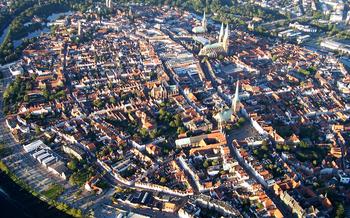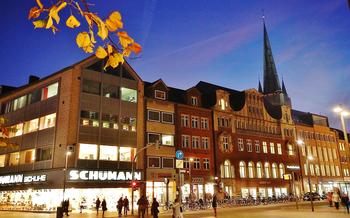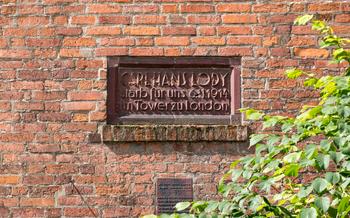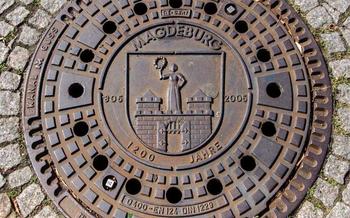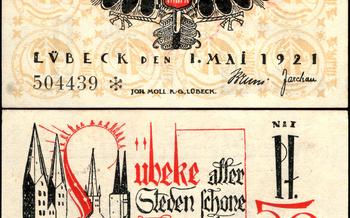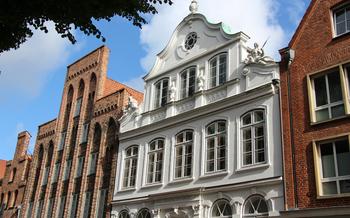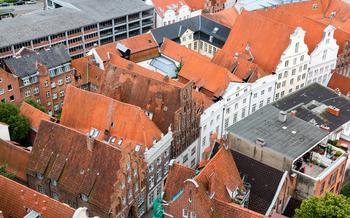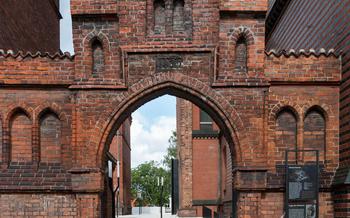
Museum Holstentor
- Lübeck's Holstentor: A Symbol of History and Resilience
- Visiting the Museum
- Permanent Exhibitions
- Temporary Exhibitions
- Architecture and Design
- Historical Significance
- Hanseatic League Connection
- City Views and Panoramas
- Café and Restaurant Options
- Shopping Opportunities
- Transportation and Parking
- Accessibility for Visitors with Disabilities
- Educational Programs and Workshops
- Insider Tip: Unveiling the Hidden Treasures of the Holstentor
Lübeck's Holstentor: A Symbol of History and Resilience
The Holstentor, an iconic symbol of Lübeck, stands proudly as a testament to the city's rich history and enduring spirit. Constructed in the 15th century, this magnificent gate served as a crucial part of the city's defense system, protecting it from invaders and securing its position as a major trading hub. Its imposing brick structure, adorned with intricate details and topped by two towering towers, reflects the architectural prowess of the era and has become an enduring symbol of Lübeck's resilience and prosperity.
As you approach the Holstentor, its sheer size and grandeur are awe-inspiring. The gate's intricate brickwork, featuring decorative patterns and glazed tiles, showcases the artistry and craftsmanship of its builders. The two round towers, each reaching a height of over 35 meters, offer breathtaking views of the city and its surroundings. The gate's imposing presence speaks volumes about Lübeck's strategic importance and its role as a gateway to the Baltic Sea.
Over the centuries, the Holstentor has witnessed countless historical events, from the rise and fall of the Hanseatic League to the ravages of the Thirty Years' War. It has stood steadfast through times of war and peace, serving as a symbol of Lübeck's resilience and determination. Today, the Holstentor stands as a beloved landmark, attracting visitors from around the world who come to marvel at its architectural beauty and immerse themselves in its rich history.
Visiting the Museum
The Museum Holstentor is open to visitors from Tuesday to Sunday, with extended hours during the summer months. Admission fees vary depending on the type of ticket purchased, with discounts available for students, seniors, and families. Guided tours are offered in English and German at specific times throughout the day, providing a comprehensive overview of the museum's history and exhibits.
For visitors with disabilities, the museum is wheelchair accessible, with ramps and elevators available to navigate the different floors. Accessible restrooms and designated seating areas are also provided for the convenience of visitors.
To avoid crowds and ensure a more personalized experience, it is recommended to visit the museum during weekdays or early in the morning. Photography is permitted in most areas of the museum, allowing visitors to capture the unique architecture and artifacts on display.
My personal experience visiting the Museum Holstentor was enriching and informative. The knowledgeable guides provided fascinating insights into the history of Lübeck and the significance of the Holstentor. The interactive displays and educational exhibits kept my attention throughout the visit, making it an enjoyable and educational experience.
Permanent Exhibitions
The Museum Holstentor houses a wealth of permanent exhibitions that delve into the rich history and significance of the gate and the city of Lübeck. One of the highlights of the collection is the impressive display of medieval artifacts, providing visitors with a glimpse into the city's past. These artifacts include coins, pottery, tools, and weapons, each telling a story of Lübeck's vibrant medieval era.
Another captivating exhibit focuses on the Holstentor's role in the city's defense system and trade routes. Visitors can admire a collection of weapons and armor used by the gate's guards, as well as models and maps that illustrate the city's strategic location and its importance as a trading hub.
Interactive displays and educational exhibits enhance the visitor experience, making the museum accessible and engaging for visitors of all ages. Touchscreens, interactive maps, and multimedia presentations bring history to life, allowing visitors to explore the Holstentor's significance in a dynamic and immersive way.
One particularly fascinating artifact in the collection is a 14th-century wooden sculpture known as the "Lübeck Madonna." This beautifully carved figure depicts the Virgin Mary holding the infant Jesus and is considered a masterpiece of medieval art. The sculpture is a testament to the artistic and cultural heritage of Lübeck and holds a special place in the museum's collection.
Temporary Exhibitions
The Museum Holstentor regularly hosts temporary exhibitions that explore diverse themes and topics related to Lübeck's history, culture, and art. These exhibitions often feature unique artifacts, interactive displays, and educational exhibits that complement the museum's permanent collection.
Past temporary exhibitions have delved into the Hanseatic League's influence on Lübeck, the city's maritime heritage, and the impact of the Thirty Years' War on the region. Upcoming exhibitions may focus on Lübeck's architectural treasures, the lives of famous historical figures associated with the city, or contemporary art inspired by the Holstentor.
Special events, workshops, and lectures often accompany temporary exhibitions, offering visitors deeper insights into the featured themes. These events provide opportunities to engage with experts, participate in hands-on activities, and learn more about Lübeck's rich history and culture.
My personal recommendation for a must-see temporary exhibition is the upcoming "Lübeck's Hidden Treasures: Uncovering the City's Secrets." This exhibition promises to showcase rare and seldom-seen artifacts from the museum's collection, shedding light on Lübeck's lesser-known stories and forgotten chapters. Visitors will have the chance to discover hidden gems, explore the city's past in new ways, and gain a deeper appreciation for Lübeck's enduring legacy.
Architecture and Design
The Holstentor's architectural style is a prime example of the Brick Gothic prevalent in northern Germany during the Middle Ages. Constructed primarily of red brick, the gate features intricate patterns and decorative elements that showcase the craftsmanship of the period. Its two imposing round towers, each adorned with a conical roof, lend a distinctive silhouette to the gate.
The gate's design incorporates several unique features. The fortified towers are equipped with arrow slits and gun ports, highlighting its defensive purpose. A drawbridge, once used to control access to the city, spanned the moat that originally surrounded the gate. The baroque-style pediment, added in the 18th century, contrasts with the Gothic elements and adds a touch of elegance.
The Holstentor's design has influenced the architectural landscape of Lübeck and the surrounding region. Other buildings in the city, such as the St. Mary's Church and the Town Hall, feature similar brickwork and Gothic elements, creating a cohesive architectural style. The gate's iconic appearance has made it a symbol of Lübeck, gracing postcards, souvenirs, and city branding.
Historical Significance
The Holstentor stands as a silent witness to Lübeck's rich and eventful past. Throughout the centuries, it has played a pivotal role in major historical events that shaped the city and the region. As a symbol of Lübeck's membership in the Hanseatic League, the gate served as a gateway for trade and commerce, contributing to the city's prosperity and influence. Its sturdy walls and imposing towers provided defense against invading armies during the Thirty Years' War, protecting the city's citizens from the ravages of conflict.
Stories and anecdotes abound about famous historical figures who graced the Holstentor's threshold. Emperors, kings, and merchants alike passed through its archway, leaving their mark on the city's history. The gate's imposing presence evokes a sense of awe and wonder, inviting visitors to ponder the tales of bravery, intrigue, and resilience that unfolded within its shadow.
The Holstentor's historical significance extends beyond its role in warfare and trade. It stands as a testament to Lübeck's enduring spirit and its ability to adapt and thrive in the face of adversity. The gate's transformation from a defensive structure to a cultural landmark reflects the city's own evolution from a medieval trading hub to a modern center of commerce and tourism.
Personally, I find the Holstentor's historical significance particularly poignant. As I stand beneath its towering archway, I can't help but feel a connection to the past, imagining the footsteps of those who came before me. The gate's weathered stones seem to whisper stories of a bygone era, inviting me to delve deeper into Lübeck's rich tapestry of history.
Hanseatic League Connection
The Holstentor stands as a testament to Lübeck's prominent role in the Hanseatic League, a powerful alliance of trading cities that dominated maritime commerce in Northern Europe during the Middle Ages. As a member of the league, Lübeck flourished as a trading hub, connecting the Baltic Sea region with the rest of Europe.
The museum houses a wealth of artifacts and exhibits that shed light on this vibrant period of Lübeck's history. Visitors can explore maps depicting the far-reaching trade routes of the Hanseatic League, marvel at replicas of medieval ships that carried precious cargo across the seas, and learn about the influential merchants who shaped the league's economic and political power.
One captivating anecdote tells the tale of a daring Hanseatic captain named Klaus Störtebeker. Known for his audacious raids on merchant vessels, Störtebeker became a legendary figure among Hanseatic sailors. The museum showcases a replica of his ship, the "Makrele," inviting visitors to imagine the thrilling adventures and perils faced by these seafaring traders.
Through its exhibits and artifacts, the Museum Holstentor brings to life the fascinating story of Lübeck's connection to the Hanseatic League, offering a glimpse into the bustling trade networks and cultural exchanges that defined this pivotal era in European history.
City Views and Panoramas
For a breathtaking perspective of Lübeck, ascend the winding staircase to the viewing platform atop the Holstentor. This elevated vantage point offers panoramic vistas that stretch across the city's red-roofed skyline, the shimmering waters of the Trave River, and the lush green countryside beyond. On a clear day, you can even catch glimpses of the distant Baltic Sea.
Capture the essence of Lübeck's charm with stunning photographs from this unique vantage point. Frame the Holstentor's imposing towers against the backdrop of the city's skyline, or capture the vibrant colors of a sunset over the Trave River.
Whether you're a photography enthusiast or simply seeking an unforgettable experience, the panoramic views from the Holstentor are not to be missed. Take your time to soak in the beauty of Lübeck from above, and let the city's rich history and captivating scenery leave a lasting impression.
Café and Restaurant Options
After delving into the history and significance of the Holstentor, you might find yourself in need of sustenance. Fortunately, the area surrounding the museum offers a tempting array of culinary options to satisfy your hunger or thirst.
For a quick bite or a refreshing beverage, I recommend Café Niederegger, located just a stone's throw from the Holstentor. This charming café is renowned for its delectable marzipan creations, a specialty of Lübeck. Indulge in a slice of their signature marzipan cake or sip on a frothy cappuccino while savoring the sweet delights.
If you're craving a more substantial meal, head to Schiffergesellschaft, a traditional German restaurant housed in a historic building nearby. Step back in time as you dine in the cozy atmosphere, surrounded by maritime artifacts and nautical décor. Their menu features hearty German dishes such as schnitzel, roasted pork knuckles, and fresh-caught fish, accompanied by a selection of local beers.
For a unique dining experience, consider booking a table at the Drehbrücke restaurant, situated on a rotating bridge overlooking the picturesque harbor. As you savor your meal, enjoy the mesmerizing views of the passing ships and the ever-changing cityscape. Their menu offers a fusion of international and local cuisine, ensuring something to tantalize every palate.
Remember to check the operating hours and make reservations in advance, especially during peak tourist seasons, to avoid disappointment. Whether you're in the mood for a sweet treat, a hearty meal, or a waterfront dining experience, the area surrounding the Holstentor has something to satisfy every culinary desire.
Shopping Opportunities
In the vicinity of the Holstentor, visitors will find a treasure trove of shopping opportunities catering to various tastes and budgets. Souvenir shops abound, offering an array of mementos and trinkets to commemorate your visit to Lübeck. From traditional Hanseatic souvenirs like miniature cogs and marzipan figurines to quirky postcards and magnets, there's something for everyone.
For those seeking unique and locally crafted items, boutiques and specialty stores line the streets near the Holstentor. Discover handcrafted jewelry, artisanal pottery, and one-of-a-kind fashion pieces that capture the essence of Lübeck's rich heritage. Whether you're looking for a special gift or a souvenir to remind you of your travels, you're sure to find something special here.
To find the best deals and authentic souvenirs, venture off the beaten path and explore the charming side streets and alleys. You'll often find hidden gems tucked away, offering unique items at affordable prices.
My personal recommendation for shoppers is to visit the charming "Lübecker Läden" (Lübeck Shops) located just a short walk from the Holstentor. This quaint shopping arcade houses a variety of independent boutiques and specialty stores, each offering a unique selection of goods. From handmade chocolates and local crafts to vintage clothing and home décor, you're sure to find something special to take home.
Transportation and Parking
Reaching the Holstentor is a breeze, whether you opt for public transportation or the convenience of your own car.
-
Public Transportation: Hop on the local bus network, which offers several lines that stop within a short walk of the Holstentor. Alternatively, take advantage of Lübeck's efficient train system, disembarking at the Lübeck Hauptbahnhof station and enjoying a leisurely stroll to the gate.
-
Car: If you prefer the flexibility of driving, you'll find several parking options near the Holstentor. Look for designated parking areas or on-street parking spaces, ensuring you adhere to any time restrictions or fees.
Here's a local's tip: To avoid the hassle of finding parking near the Holstentor, consider exploring Lübeck's charming streets on foot or by bike. The city's compact size and pedestrian-friendly layout make it easy to navigate and discover its hidden gems.
Accessibility for Visitors with Disabilities
The Museum Holstentor is committed to providing an inclusive and accessible experience for all visitors, including those with disabilities. The museum is wheelchair accessible, with ramps and elevators available throughout the building. Accessible restrooms and designated seating areas are also provided for the comfort and convenience of visitors with mobility challenges.
To further enhance the experience for visitors with disabilities, the museum offers audio guides that can be used with personal headphones. These audio guides provide detailed descriptions of the exhibits, allowing visitors to learn about the history and significance of the Holstentor without any barriers.
For visitors who may require additional assistance, the museum staff is always happy to provide guidance and support. They can help with navigation, offer alternative formats for educational materials, and arrange for sign language interpretation if necessary.
With these accessibility features and the dedication of the museum staff, visitors with disabilities can fully enjoy and appreciate the Museum Holstentor and its fascinating exhibits.
Educational Programs and Workshops
The Museum Holstentor offers a range of educational programs and workshops tailored to visitors of all ages, particularly families with children. These programs aim to bring history to life and make learning fun and interactive.
One popular program is the "Medieval Adventure," where kids can dress up in period costumes, engage in hands-on activities, and learn about the daily lives of people during the Hanseatic era. Another program, "Treasures of the Hanseatic League," takes participants on a scavenger hunt through the museum, uncovering hidden artifacts and stories related to the league's rich history.
To ensure a spot in these programs, it's advisable to book in advance, especially during peak tourist season. Check the museum's website or inquire at the information desk for schedules and availability.
I had the opportunity to participate in the "Medieval Adventure" program with my family, and it was a fantastic experience. My kids were enthralled as they explored the museum dressed as knights and princesses, solving puzzles, and learning about the past in a playful way. It's a great way to combine education with entertainment, creating lasting memories for the whole family.
Insider Tip: Unveiling the Hidden Treasures of the Holstentor
Beyond the captivating exhibits and historical narratives, the Holstentor holds a hidden gem waiting to be discovered. As you explore the museum, keep an eye out for the inconspicuous door nestled within the gate's massive structure. This unassuming entrance leads to a secret chamber that once served as a prison during the Middle Ages. Step inside, and you'll be transported back in time, surrounded by the remnants of a forgotten era. The dimly lit room, with its thick walls and barred windows, evokes a sense of mystery and intrigue. Imagine the stories these walls could tell of the prisoners who once languished within, their hopes and fears etched into the very stones.
For a truly immersive experience, visit the Holstentor during one of the special guided tours that delve into its hidden history. These tours offer a rare glimpse into the gate's darker past, shedding light on the lives of those who were incarcerated within its walls. Listen as your guide narrates tales of daring escapes, harsh punishments, and the resilience of the human spirit in the face of adversity.
Whether you choose to explore the secret chamber on your own or join a guided tour, this hidden gem adds an extra layer of intrigue to your visit to the Holstentor. It's a reminder that history is not always confined to the pages of books but can be found in the most unexpected places, waiting to be uncovered by curious minds.
